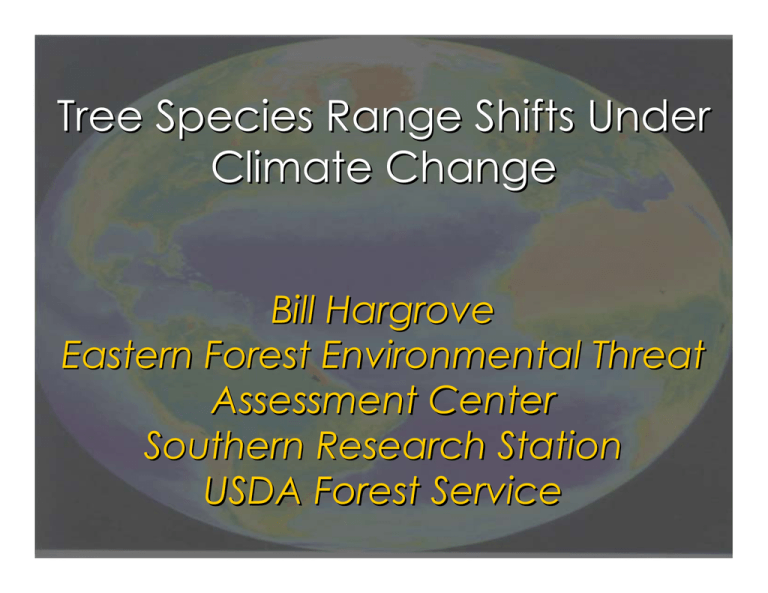Tree Species Range Shifts Under Climate Change
advertisement

Tree Species Range Shifts Under Climate Change Bill Hargrove Eastern Forest Environmental Threat Assessment Center Southern Research Station USDA Forest Service A Taxonomy of Range Models Statistical/Empirical Models Gap Models LANDSUM, SHIFT Biogeochemical Models FORET, LINKAGES Landscape Models DISTRIB, GARP, GAM, GLM, Biomapper (ENFA) CENTURY Dynamic Global Vegetation Models MC-1, MAPSS, LPJ Using DISTRIB, a statistical model, and SHIFT, a cell-based model, to assess potential climate change impacts on forests in the Eastern U.S. Louis Iverson, with Anantha Prasad, Steve Matthews, Matt Peters US Forest Service Northern Research Station Delaware, Ohio Climate Change Tree Atlas Climate Change Bird Atlas http://www.nrs.fs.fed.us/atlas Forest Inventory and Analysis • FOREST INVENTORY (US Forest Service) – – – – 37 states east of 100th meridian 134 tree taxa 103,488 plots, ~1 plot per 2400 ha of forest 2,938,518 tree records • PROCESS – Extract latest FIA plot data by State – Calculate Importance Value based on number of stems & basal area – Aggregate points to 20 x 20 km polygons • OUTPUT – Importance Value (IV) for 134 tree species, by 20 km cell Available online: Prasad and Iverson 2003 Quercus alba Environmental Predictor Variables •Response variable: FIA-derived importance values by 20 km Climate AVGT JANT JULT TMAYSEPT PMAYSEPT PPT JANJULDif Mean annual temperature (deg. C) Mean January temperature (deg. C) Mean July temperature (deg. C) Mean May-September temperature or precipitation Annual precipitation (mm) Difference temp Jan/Jul Elevation ELV_CV ELV_MAX ELV_MEAN ELV_MIN ELV_RANGE Elevation coefficient of variation Maximum elevation (m) Average elevation (m) Minimum elevation (m) Range of elevation (m) Soil Class ALFISOL ARIDISOL ENTISOL HISTOSOL INCEPTSOL MOLLISOL SPODOSOL ULTISOL VERTISOL Alfisol (%) Aridisol (%) Entisol (%) Histosol (%) Inceptisol (%) Mollisol (%) Spodosol (%) Ultisol (%) Vertisol (%) Soil Property BD CLAY KFFACT NO10 NO200 OM ORD PERM PH ROCKDEP ROCKFRAG SLOPE TAWC Soil bulk density (g/cm3) Percent clay (< 0.002 mm size) Soil erodibility factor, rock fragments free Percent soil passing sieve No. 10 (coarse) Percent soil passing sieve No. 200 (fine) Organic matter content (% by weight) Potential soil productivity, (m3 of timber/ha) Soil permeability rate (cm/hour) Soil pH Depth to bedrock (cm) Percent weight of rock fragments 8-25 cm Soil slope (percent) of a soil component Total available water capacity (cm, to 152 cm) Land Use and Fragmentation AGRICULT FOREST FRAG NONFOREST Cropland (%) Forest land (%) Fragmentation Index (Riitters et al. 2002) Non-forest land (%) 3 Climate Models Hadley CM3 (Severe) PCM (Mild) GFDL 2 Scenarios A1FI (Low or Best) B1 (Hi or Worst) Current Hadley Hi Current Hadley Hi Regression Tree Analysis (RTA) TJuly< 16.5 •A single (best) predictor is selected to split the data PPT < 750 pH > 6 MElev > 500 •Additional best predictors 35 Alfisol < 15 are selected for each n=200 6.5 0.5 subset of data, thus 2.4 n=300 n=1800 creating ‘branches’ of a 63 n=85 15 TJuly < 16.5 & ‘tree’ n=150 n=95 PPT < 750 & PH <= •At the6bottom is series of terminal nodes which contains the predicted Highly suited for distributional mapping where value of species importance different variables operate •These values are then mapped at different geographic regions – can map predictor-rules driving the distribution. Iverson and Prasad 1998 Ecological Monographs Tree-based ensemble (the “Tri-mod approach”) Regression Tree Analysis (RTA or CART) (help understand relationships, map drivers) Bagging Trees (BT) - combines 30 trees using bootstrap sampling and averages the results (use 30 trees to assess variability among individual tree models = a measure of model reliability) Random Forest (RF) - combines 1000 trees like in BT, but each with a randomized subset of predictors (best for prediction without overfitting) Model Reliability Hi Med Low Mean Center Potential Movement - Trees Important! With these models, we are predicting potential suitable habitat by year 2100. We are NOT predicting where the species will be at that time, as great lag times are involved in tree species migrations. Trees live a long time and move slowly (~50 km/century in the Holocene). Suitable Habitat Potential Changes – Ave lo and hi emissions Potential species changes in area-weighted importance value for habitat suitability (Chicago region) Future: current ratio Scenario < 0.5 PCM lo Ave lo 32 35 0.5 0.9 17 22 0.9 - 1.1 - 2 1.1 6 26 13 17 >2 Total 33 33 114 114 Ave hi 43 17 4 17 33 114 Had hi 44 18 8 15 27 114 A future : current ratio below 1 indicates a loss (red), while a value above 1 indicates a gain (green). Forest Types from combinations of species. Animation of colonization using presettlement vegetation – Pinus virginiana in Ohio Current DISTRIB SHIFT Constrained by DISTRIB and SHIFT Potential effects of climate change on the tree species of Hoosier NF, Indiana Top Habitat Gainers Top Habitat Losers Change in average importance value of suitable habitat on the forest averaged across climate and emission scenarios Conclusion: Lots of models Lots of predictions Lots of disagreement We need long-term forest health monitoring to sort them out For Further Information Web site for most data presented today: Little’s boundaries FIA data grouped by 20x20 km cell Climate change atlases Species-environment data for 134 trees Pdfs of related papers www.nrs.fs.fed.us/atlas For free hard copy of atlases or reprints: liverson@fs.fed.us Thanks to USDA FS Northern Global Change Program for support

